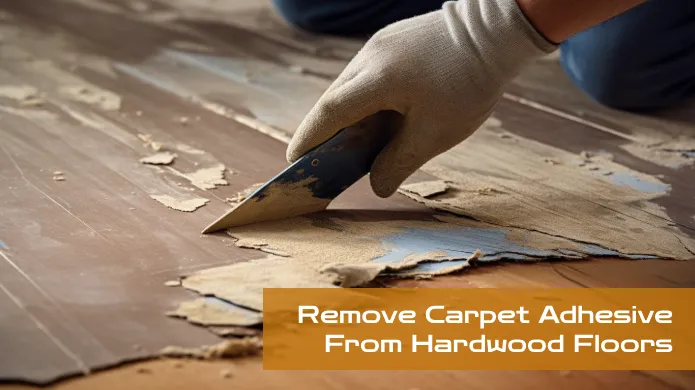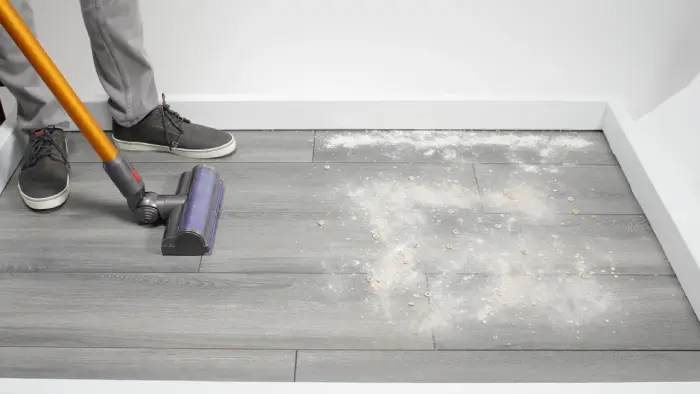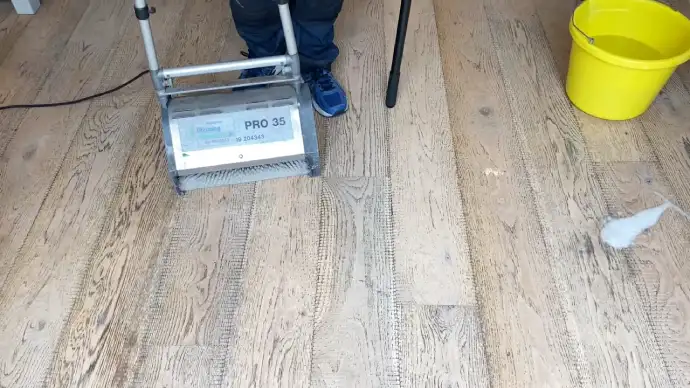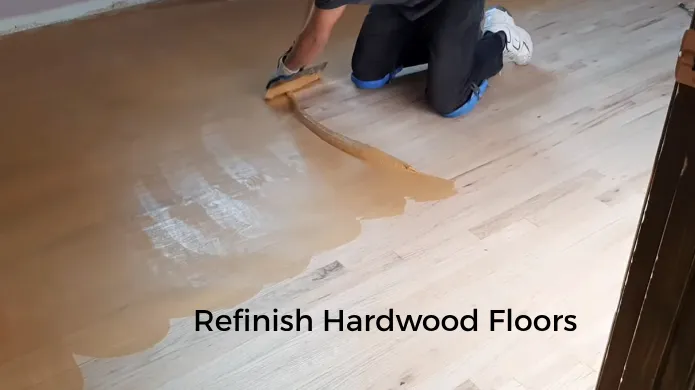A drop zone in your home is a designated spot near an entrance where you can quickly set down keys, bags, shoes, and mail. It helps you stay organized by preventing clutter and keeping essentials within easy reach.
Often found in foyers or mudrooms, drop zones include hooks, trays, benches, and storage bins tailored to your household’s needs. Creating one streamlines your daily routine and keeps your space tidy. Keep exploring for ideas to customize yours perfectly.
Key Takeaways
- A drop zone is a designated area near home entrances for quickly placing keys, bags, mail, and everyday essentials.
- It helps reduce clutter and organizes household items for easy access and efficient daily routines.
- Drop zones typically include hooks, trays, baskets, and seating to accommodate coats, shoes, and personal belongings.
- These spaces are customizable to fit family needs and integrate seamlessly with home décor and traffic flow.
- A well-designed drop zone supports household order, streamlines routines, and minimizes stress by keeping essentials accessible.
Definition and Purpose of a Drop Zone
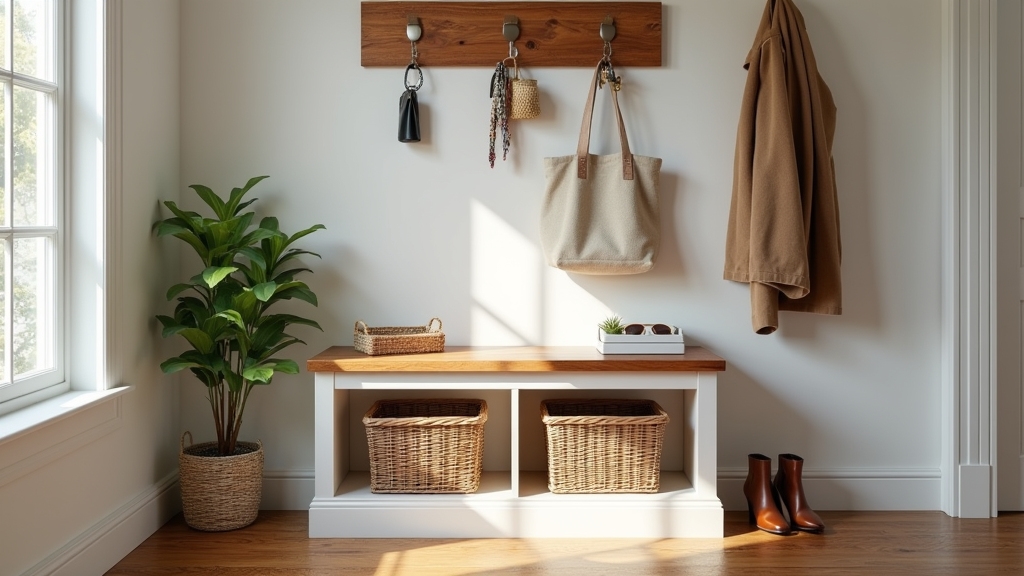
Although you mightn’t have thought about it before, a drop zone is a simple yet effective space in your home where you can quickly set down everyday items like keys, bags, and coats as you come and go.
A drop zone is a handy spot to quickly set down keys, bags, and coats as you come and go.
It’s a designated spot designed for convenience and organization, helping you keep frequently used belongings in one place. This area can be permanent or temporary, depending on your household needs.
Drop zones can be located in various entryways such as foyers, mudrooms, or kitchen corners to best fit your home’s layout. Incorporating such a space can reduce clutter and maintain household order.
By using a drop zone, you prevent clutter from spreading throughout your living spaces and make it easier to locate essentials when you’re heading out.
Tailored to your family’s routine, it streamlines daily tasks and supports overall household order, making your home more efficient and less chaotic.
Common Locations for Drop Zones in Homes
You can set up drop zones in several key spots around your home to keep everyday clutter under control.
Common locations include the garage entry, where hooks and shoe organizers help manage coats and bags right as you come in. Regular maintenance of these areas helps prevent clutter buildup and keeps the space functional.
Mudrooms offer a transitional space with benches and cubbies for outdoor gear, perfect for families. These areas often include multipurpose furniture that provides both seating and storage, enhancing functionality.
In the foyer or entryway, you can use shelves and hooks to organize keys, mail, and wallets, streamlining daily routines. Establishing designated spots reduces the chance of misplaced items and improves daily efficiency.
Back hallways serve as discreet overflow areas for backpacks or sports equipment, keeping main areas tidy. Consistent organization in these spaces helps maintain the overall cleanliness of your home.
Finally, kitchen-adjacent drop zones near entrances help you sort groceries and mail quickly with baskets and hooks. Using regular cleaning routines in these zones ensures debris and clutter do not accumulate.
Essential Features and Components of a Drop Zone

When setting up a drop zone, it’s super helpful to have dedicated spots for your coats and keys. This way, you can keep your everyday essentials right where you need them. Plus, who doesn’t love a tidy space? Adding some surface preparation strategies can help keep the area clean and organized.
Now, let’s talk about shoe organization. Cubbies or racks can be game changers! They help keep the floors clear and make it easier to manage clutter. Trust me, you’ll appreciate not tripping over shoes when you walk in.
And don’t forget about seating! Adding a little bench or chair not only boosts comfort but also makes your routine smoother. It’s so much easier to sit down when you’re putting on or taking off your shoes. Consider choosing benches with hidden storage to maximize space and functionality.
Coat and Key Storage
When setting up coat and key storage in your drop zone, prioritize functionality and accessibility to keep your entryway organized. A well-designed drop zone helps reduce clutter on floors and counters, setting a welcoming tone for the home. Regularly remove dirt and debris to maintain the space’s appearance and durability.
Install multiple rows of durable hooks at varying heights to accommodate adults and children. Consider retractable hooks to save space. Choose corrosion-resistant hardware to handle wet outerwear and match your entryway’s style.
For keys, use designated trays, bowls, or magnetic hooks inside cabinets to keep them secure and easy to find. Label key areas if you share your home to avoid confusion.
Position your coat and key storage near primary entry points or on the back of a door to maximize convenience. Integrate slim consoles or cubbies if space allows, combining storage with seating or charging stations to enhance usability without clutter.
This approach promotes a healthy indoor environment by reducing unnecessary mess and improving organization.
Shoe Organization Solutions
Alongside coat and key storage, managing shoes effectively plays a big role in keeping your drop zone tidy. You can use shoe racks, baskets, or large plastic containers to keep footwear organized and easily accessible.
Boot trays made of wood, rubber, or metal help trap water and dirt, protecting your floors. Enclosed cupboards with multiple compartments let you store seasonal shoes and accessories neatly out of sight. Using a boot tray is especially helpful in preventing sticky hardwood floor issues caused by dirt and moisture.
Utilizing space under benches or in lower cabinets maximizes vertical storage. Consider baskets to separate house shoes, dog accessories, or seasonal gear, keeping everything in order.
Multi-functional units that combine shoe storage with benches and hooks offer all-encompassing organization. These practical solutions help you maintain a clean, clutter-free entryway while managing shoes efficiently. Additionally, placing doormats outside helps trap dirt and water before entering, reducing indoor mess.
Seating and Convenience
How can you make your drop zone both functional and inviting? Start with comfortable bench seating, giving you a spot to sit while putting on or taking off shoes.
Choose benches with lift-up lids or drawers to tuck away daily essentials, keeping clutter out of sight. Add upholstered cushions with durable fabrics to soften the look without sacrificing wear resistance.
Entryway options include classic benches, contemporary lockers, and networking nooks that can further enhance the space. It’s also important to ensure your materials are gentle and protective, similar to selecting appropriate carpet materials to avoid damage and maintain durability.
For convenience, include slim console tables or countertop surfaces nearby to hold keys, sunglasses, and mail. Use trays or small bowls to keep loose items contained.
Position your drop zone near natural entry points like garage or back doors to fit your family’s routine. This thoughtful seating and surface setup encourages daily use and helps maintain order, making your drop zone a practical, welcoming transition space.
Differences Between Drop Zones and Mudrooms
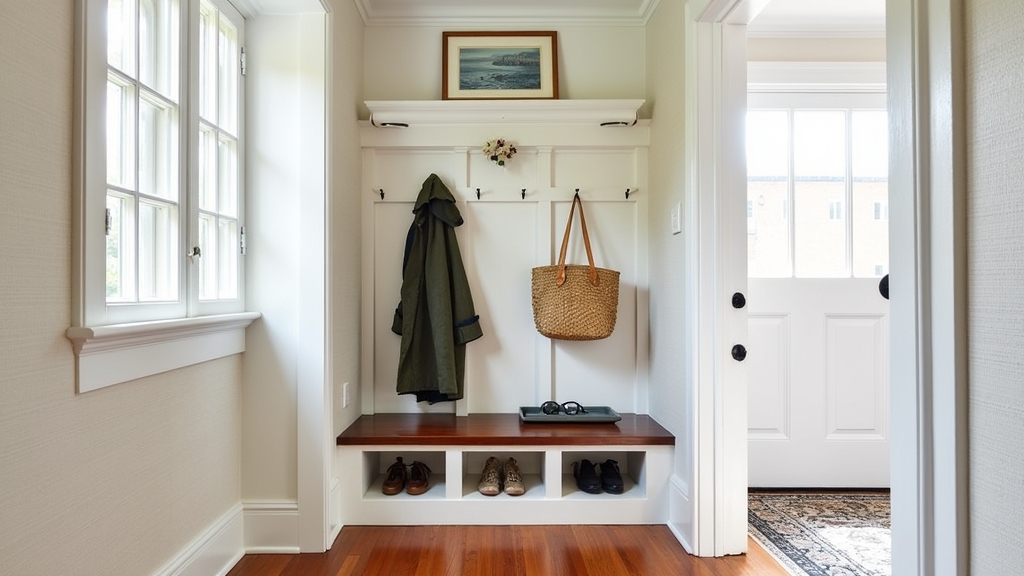
Although both drop zones and mudrooms help keep your home organized, they serve different purposes and suit different needs.
Drop zones offer quick, general storage for everyday items near entrances, while mudrooms handle wet, muddy gear with durable flooring and cleaning tools.
The design of drop zones is often customizable to fit the specific needs and space of the household, making them adaptable for various home sizes and layouts with customizable storage components. Proper use of protective coverings can also help maintain these spaces during heavy use.
Drop zones fit compact spaces; mudrooms require larger, dedicated areas.
| Feature | Drop Zone | Mudroom |
|---|---|---|
| Purpose | Organize keys, mail, shoes | Manage dirt, wet clothes, boots |
| Location | Near main entrance or hallway | Between garage and kitchen |
| Flooring | Standard, non-waterproof | Waterproof, durable materials |
| Size | Compact | Larger (6’x6’ to 7’x9’) |
| Features | Hooks, cubbies, benches | Laundry baskets, boot scrubbers |
Benefits of Having a Drop Zone
Choosing a drop zone over a mudroom can bring several practical benefits to your daily routine and home environment.
Opting for a drop zone enhances daily organization and streamlines your home’s entryway functionality.
It provides a designated spot for essentials like keys, shoes, and backpacks, preventing clutter from spreading throughout your home. This organization saves you time by ensuring quick access to frequently used items, reducing stress and last-minute searches.
Drop zones also protect your floors and furniture by containing dirt, mud, and debris, lowering cleaning efforts. Proper preparation and environmental control can further help in maintaining the condition of your flooring.
They often include storage solutions like hooks, shelves, and cubbies to keep items neatly arranged. Additionally, they enhance home functionality by integrating charging stations and mail sorting areas, improving convenience at entry points.
Customizing Drop Zones for Family Needs
When it comes to designing your drop zone, think about what works best for your family’s unique needs. For instance, if you have little ones, it’s a great idea to add some child-friendly storage that they can easily reach. You want to make it easy for them to put their things away, right?
And if your family is into sports, organizing gear can be a game changer. You can use designated bins or hooks to keep everything in its place after practice. Trust me, it really helps cut down on the clutter! Choosing durable materials like maple hardwood can ensure your drop zone withstands heavy daily use.
Oh, and let’s not forget about your furry friends! If you have pets, make sure to carve out a spot for their leashes, treats, and cleaning supplies. Having everything handy and tidy will make your life so much easier!
Many homeowners find inspiration on platforms like Houzz, where you can explore millions of photos of drop zones filtered by room, style, and color to suit your design preferences.
Child-Friendly Storage Solutions
How can you make your drop zone both functional and fun for your kids? Start by choosing child-friendly storage solutions that keep things accessible and organized. Selecting materials treated to be fire resistant can add an extra layer of safety for families.
Consider multi-functional furniture like storage benches that double as reading nooks or stackable bins that save space. Personalize the area with colors and designs your kids love to encourage use.
Safety is key; look for anti-tip features and non-toxic materials. Use modular, foldable cupboards to maximize small spaces, especially in urban homes. Many parents now prefer furniture with rounded corners and adjustable components to enhance safety.
Opt for eco-friendly materials like bamboo or FSC-certified wood for durability and sustainability. Incorporate toy storage that balances easy access with clutter control, supporting independent tidying.
Sports Equipment Organization
Organizing your drop zone to fit your family’s sports gear helps keep busy mornings smooth and clutter under control.
Install wall hooks, pegboards, or slatwall panels to hang helmets, bats, and gloves, keeping bulky items off the floor. Maximizing wall space with adjustable shelves and hooks can greatly increase storage capacity in smaller areas, making organization even more efficient maximize wall space.
Use adjustable shelves and labeled bins for smaller gear, making it easy for everyone to find what they need. Incorporate shoe racks and benches near entry points for quick changes into cleats or sports shoes.
Customize with modular units or IKEA ALGOT systems to create individual zones for each family member, promoting independence. Durable bins and mesh baskets keep balls and padding organized and visible.
Pet Owner Essentials
When customizing your drop zone for pet owner essentials, focus on creating designated spaces tailored to your pets’ specific supplies and needs. Organize areas for food, grooming, and transportation items to keep everything accessible and neat.
Use waterproof bins or mats for wet gear and guarantee cleaning supplies are stored separately but within reach. Adapt the setup according to your pets’ types and family members’ accessibility.
Since many pet owners are tech-savvy shoppers, consider incorporating smart storage solutions or charging stations for automatic feeders and monitoring devices. Consider including hooks or racks for leashes, collars, and waste bags near entry points for quick grabs.
Also, add shelving or cubbies with airtight containers for food, treats, and medications to maintain freshness. Incorporate a washable bench or tray area for grooming tools and a spot to separate clean and dirty items to prevent cross-contamination.
Tips for Organizing an Effective Drop Zone
Since the drop zone serves as the gateway to your home, you’ll want to keep its contents limited to essential daily items only.
The drop zone is your home’s gateway—keep it simple with only essential daily items.
Designate specific storage for shoes, keys, backpacks, and frequently used accessories to prevent clutter. Use hooks, baskets, and drawers with dividers to separate items neatly, and choose furniture like benches with cubbies to combine storage and seating.
Place the drop zone near your main entrance for easy access, matching your household’s flow. Customize the area with labeled bins for quick identification and rotate seasonal items regularly. Add trays or baskets to keep items contained and consider decorative touches to make the space inviting.
Keep essential items visible and accessible to save time and maintain order effortlessly. Regularly edit and re-home items when storage becomes overfilled to prevent clutter buildup.
How Drop Zones Improve Daily Home Routines?
Although it may seem like a small detail, having a well-designed drop zone can considerably streamline your daily routines by keeping all your essentials in one accessible spot.
You’ll save time searching for keys, bags, or mail, especially during busy mornings or after school. A drop zone encourages you and your family to develop consistent habits, reducing clutter and stress.
Materials include wood, metal, wicker, with various colors and finishes allow you to customize the drop zone to match your home décor and personal style. Here’s how a drop zone improves your home routines:
- Centralizes everyday items like shoes, coats, and backpacks, preventing messes in living spaces.
- Provides a dedicated area for mail and paperwork, helping you stay organized.
- Supports accountability by giving each family member a specific spot for their belongings.
With these benefits, your daily handoffs become smoother and your home stays tidier effortlessly.
Frequently Asked Questions
Can a Drop Zone Be Added to an Existing Home Without Major Renovations?
Yes, you can add a drop zone to your existing home without major renovations. Use portable storage like baskets or trays near your entry. Install wall hooks or small shelves with minimal hardware.
You can also repurpose a corner of your kitchen counter or garage shelf. These simple solutions keep your essentials organized and clutter-free. They adapt easily as your needs change, all without the hassle or cost of remodeling.
What Materials Are Best for Durable Drop Zone Furniture?
For durable drop zone furniture, you’ll want solid hardwoods like oak or maple since they’re tough and refinish well. Eucalyptus and rubber wood also handle heavy use.
Plywood with hardwood veneer offers stability and affordability. Don’t overlook moisture-resistant finishes like waterborne polyurethane to protect surfaces.
Adding waterproof trays and corrosion-resistant hardware helps too. If you want easy cleaning, consider powder-coated steel frames or laminated composite woods for strength and low maintenance.
How Do Drop Zones Affect Home Resale Value?
You might think adding a drop zone won’t impact resale value, but it actually does. Buyers, especially families and millennials, see drop zones as practical and modern, boosting your home’s appeal.
They help keep clutter controlled and improve organization, which makes your home feel more spacious and functional. This added convenience can speed up sales and increase your home’s market value, making it a smart investment that pays off in the long run.
Are There Smart Home Integrations for Drop Zones?
Yes, you can easily integrate smart home technology into your drop zone. Motion sensors can trigger lighting automatically when you enter, while smart locks offer keyless entry and remote access.
Notifications alert you if doors stay open or if your drop zone needs tidying. You can also control climate with automated shades and ventilation.
These integrations make your drop zone more convenient, secure, and energy-efficient, all manageable from your smartphone or voice assistant.
Can a Drop Zone Be Child-Proofed Effectively?
Absolutely, you can child-proof a drop zone effectively. It’s like building a fortress for your little explorers. By securing cabinets with locks, anchoring furniture to walls, and using outlet covers, you cut off access to hazards.
Keep sharp objects and small items out of reach or locked away. With simple, consistent measures, you create a safe, organized space that protects children without sacrificing adult convenience.
Create Convenience and Consistency with a Family-Friendly Drop Zone
Creating a drop zone helps you stay organized, saves you time, and reduces daily stress. It keeps your keys, bags, and shoes in one place, making your mornings smoother and your evenings easier.
By customizing your drop zone to fit your family’s needs, you create a space that works for you. Embrace this simple change to bring order, convenience, and calm into your home every single day.

